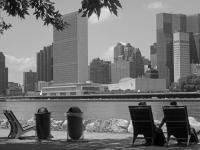Padeone Office and Exhibition Space
Beijing, China
Revitalizing Theatrical Hutong-scape | Hutong, timeline of the city prolonging and preserving local memories
Hutong carries the local history that displays historic traces of different times. With the process of modernization, the function of Hutong becomes more dynamic and diversified. One representative example is the particular courtyard house that we explored in this project. It was a typical residence in old town Beijing and was once operated as a hostel since 1998; yet in 2014, under the policy of renewing the old town, it was changed to a small theatre in steel structure. Now it will soon serve as the office and exhibition space of PAGEONE Bookstore, though it cannot be permanent either.
Hutong breeds vitality and inclusiveness. Given that the function of the courtyard might change again, we have adopted a light and flexible approach – we aimed for retaining memories of the site and keeping the dynamics of the city and Hutong while refining the main structure; and we managed to present multiple layers of Hutong experiences on top of a limited spatial and temporal condition.
Based on the existing spatial composition, we have redefined the space and its internal substances, contrasted new materials with old ones, and adjusted the spatial scale and light ambiance. Through these endeavors, we have tried to create a unique and authentic Hutong experience under the initial context.
From Hutong to office space, a redefined theatrical hutong-scape
The sunken theatre space, skylight and the yard are inspiring elements in Hutong. By moderate design, people will experience a series of scenarios while wandering from the hutong street to the layering spaces with gradually changing ambience and scale. People can experience several vivid scenes through shades of light and space if they walk from the Hutong street into this site, just like wandering in a theatre.
The exhibition space at the entrance is bright and lively, whereas the following corridor on the eastern side of the yard is redesigned as a tranquil and dark gallery. The dialogue between itself and the yard is specified as a personal reading space that extends out into the courtyard.
The gallery connects two spaces of separate functions, namely the exhibition space and the office space, leveraging light in order to deliver a message to visitors at large – there exists a gradual transition from external bustle to internal tranquility.
The initial sunken space is reconstructed as the office space. A layer of metal mesh is installed to suspend above the office area, emphasizing the boundary and taming the direct sunlight. It also meets the needs of office lighting and poster hanging. Additionally, the height of the metal mesh layer rescales the sunken space into a comfortable office space.
The ground floor around the sunken space functions as an annular circulated gallery for visitors. We keep the initial flooring-the black embossed steel plate from the entrance to the office space. While walking it through, people can get a feeling of walking onto the stage and be reminded of the venue’s previous usage, thanks to the unique texture of the steel plate and the layering space of initial steel plate walls and newly inserted perforated plate cabinets. Placed along the two long sides of the space, the two sides of cabinets grow upward and offer ample storage for the office space; as for the gallery, the shelves on the top serve as displaying, reading and writing space for visitors. Furthermore, it stands as a seeing/seen interface between office users and visitors.
Releasing space by opening up Hutong
The entrance, the north and south facades of the yard are the three transparent interfaces that link the entire space to Hutong. Visually speaking, all the connected spaces can be seen through, including Hutong, the exhibition space, the yard and the office space. These spaces stand alone and stay associated. After opening the aligned sliding doors of the three facades, a straight path turns the separate spaces into one flowing space.
The entrance space is used for exhibitions and meetings. Besides, exhibition activities will be held regularly to interact with the community outside and the library on the opposite side. In order to divide spaces flexibly, we have implanted cross-shaped movable walls made of OSB boards and steel rails member under the existing steel structure. With these walls being moved, the two small meeting rooms on the east side can be merged into one large meeting room; or else, they can be used as an extension of the exhibition space on the west side.
In terms of selecting materials for the revitalization, we have taken the critical requirements of time and budget into account – we used the effective plywood and OSB board, as well as the galvanized steel sheet, metal mesh and polycarbonate sheet which usually appear in illegal additions to Hutong houses. We have tried to take advantage of common and economical materials in Hutong in hope of realizing their quality and value in most appropriate settings.
The composition of hutong becomes complex and even fragmented, in the progress of modernization and urbanization. Comparatively, our attempt can also be a part of the overall social transformation. Therefore, from its design, construction to being in use, the project represents our objective of creating free spaces, so that people can have the opportunity of accumulating the individual Hutong memories and gradually become an urban collective memory of the hutong, a particular Hutongscape.
- Architects
- MINOR lab
- Location
- 三井胡同, Beijing, China
- Year
- 2018
- Client
- PAGEONE bookstore






















